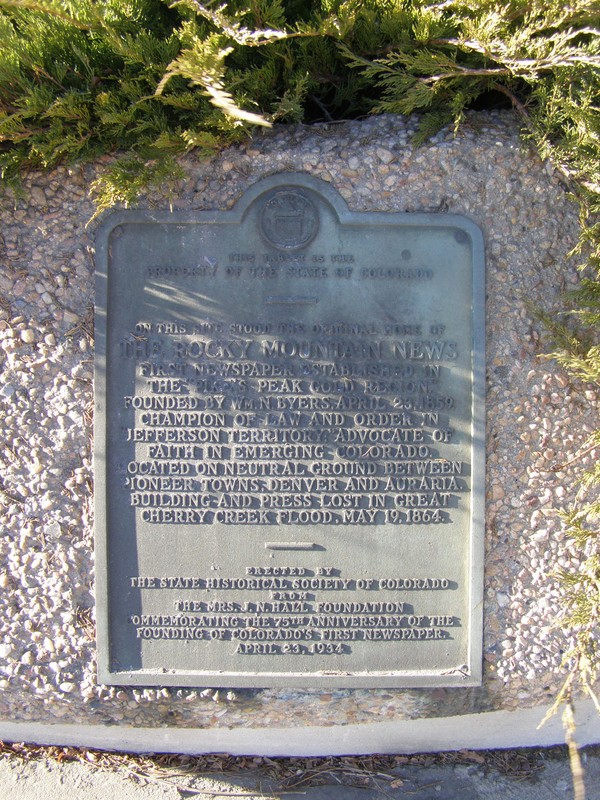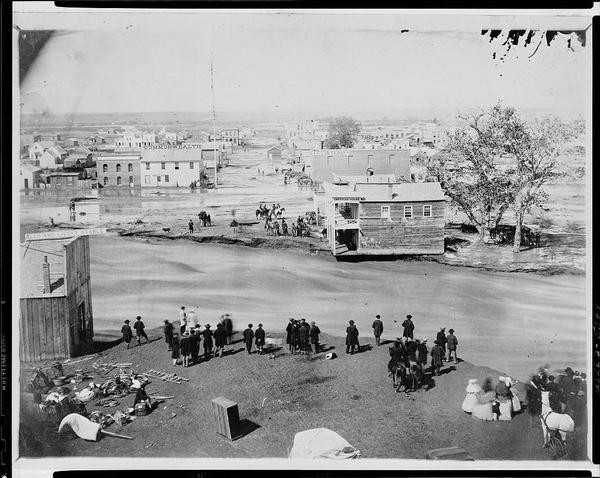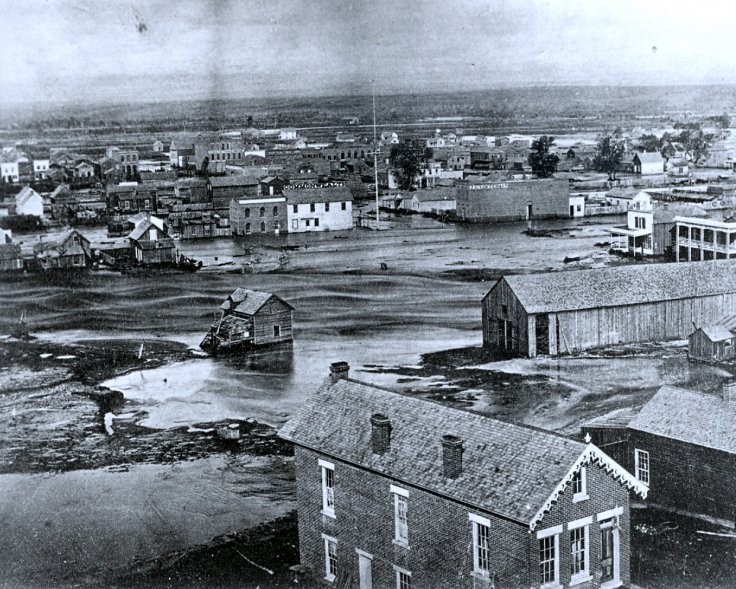Cherry Creek Flood of 1864
Introduction
Text-to-speech Audio
The Cherry Creek Flood of 1864 was one of the most noted events in Colorado history, and although other floods have ravished downtown Denver, the Cherry Creek Flood was easily the most destructive. Following spring rains and a particularly violent storm, flash floods flooded the areas along Cherry and Plum creeks. At the time, Denver rested on the northeastern bank of Cherry Creek. The neighboring town of Auraria, however, was lower than Denver on the southwest bank, and most of Auraria was quickly underwater. An estimated 15 to 20 people died in the flooding.
At this site once stood the original home of the Rocky Mountain News, the first newspaper established in the Pike’s Peak Gold Region. Among many other historically crucial buildings and enterprises that created Denver in the 1860s, the Rocky Mountain News building was destroyed in by the wrath of the flood.
Images
Historical Marker for the Rocky Mountain News Building

People stand on the banks of Cherry Creek during Denver's Great Flood on May 19, 1864. (From the Library of Congress Digital Archives)

Denver was on higher ground along Cherry Creek so it sustained less damage during the flood than Auraria, which was a separate city at the time. Photo: Courtesy of Tom Noel Collection

Backstory and Context
Text-to-speech Audio
History of the Cherry Creek Flood 1864
When the first white settlers began building homes and buildings near the dry beds of Cherry Creek in Denver, local Arapaho Chief Little Raven warned how the river floods unexpectedly. Among the group of settlers was William N. Byers, who later established Rocky Mountain News in 1859. In building Colorado Territory’s first newspaper, Byers first began printing in a saloon attic and soon constructed a building at the very same Cherry Creek dry bed that Chief Little Raven warned about.
Prior to the week of May 19th, 1864, heavy rains continually battered the Cherry Creek drainage and, consequently, saturated the ground. According to Prof. O. J. Goldrick, an eye-witness of the flood, on the evening of May 19th, the flood struck “about the midnight hour of Thursday, when almost all in town were knotted in the peace of sleep, deaf to all noise and blind to all danger, snoring in calm security ... while the full-faced queen of night shed showers of fertility, fringing the feathery cottonwoods with lustre, enameling the housetops with coats of pearl.”
According to Nathan A. Baker, who was in the Rocky Mountain News building, “I looked out of the window and saw a wall of water six feet high rushing down the dry creek bed at terrific speed. Before we could escape from the building, the flood waters reached an embankment connecting the plant with the high shores of the creek. In a few seconds we were completely isolated, with raging water surrounding the building.”
The Rocky Mountain News building was ultimately destroyed in the flood, among many other buildings and bridges. The water throughout the city became quite contaminated, threatening a major epidemic in the area. Yet, despite the deaths and over a million in damage, rebuilding in Denver began almost immediately.1
New York Times Article on the Flood, May 25th, 1864
FROM DENVER CITY.; A Flood Great Destruction of Property Loss of Life, etc.
DENVER CITY, Sunday, May 22.
Cherry Creek, which has been dry within and several miles above this city since 1859, suddenly filled with water at midnight on the 19th inst., over flowing its banks, submerging West Denver, and doing immense damage to property.
Fifteen or twenty persons have been drowned, and about fifty dwellings swept away.
Large numbers of cattle and sheep are drowned.
Among the buildings destroyed are the Rocky Mountain News Office, the City Hall and several other brick buildings.
All the bridges across Pattee and Cherry Creeks were swept away, and hundreds of farms for miles above and below them, with their growing crops, were completely ruined. Some places are covere with water from six to twelve inches deep.
The loss of property is estimated at over a million of dollars.2
Sources
1.) Tom Noel, "Noel: Lessons from Denver's flood of 1864." The Denver Post, published October 11, 2013, accessed February 28, 2016, http://www.denverpost.com/ci_24284669/lessons-from-denvers-flood-1864
2.) "FROM DENVER CITY.; A Flood Great Destruction of Property Loss of Life, etc." The New York Times, published May 25, 1864. Accessed February 28, 2016, http://www.nytimes.com/1864/05/25/news/from-denver-city-a-flood-great-destruction-of-property-loss-of-life-etc.html
